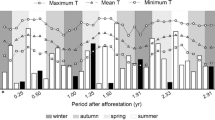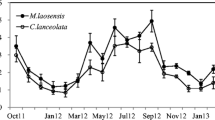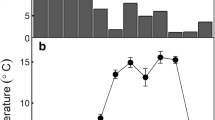Abstract
Key message
Soil respiration in a Moso bamboo forest was very sensitive to high temperatures, while ordinary annual soil respiration was comparable to that of other forests.
Abstract
Moso bamboo (Phyllostachys pubescens) is expanding aggressively by replacing pre-existing vegetation in areas of East Asia such as Taiwan. Such changes in species composition in forest ecosystems have the potential to alter soil respiration (R S) through changing soil carbon (C) processes. This study aimed to characterize the R S in a Moso bamboo forest by determining temporal variations in R S and estimated annual R S in a pure Moso bamboo stand in central Taiwan. The annual R S in the Moso bamboo stand was also compared with that in adjacent coniferous forests and reports in the literature relative to annual litterfall C. Although distinct diurnal variations in R S were found on days with higher R S and soil temperature (T S), R S measured at a single time between 7:00 and 14:00 h showed considerable concordance with the daily mean R S. Seasonal R S variation reflected variations in T S with minimum values in winter and maximum values in summer. This seasonal dynamic change in R S was predicted by the exponential function (r 2 = 0.57) with T S. The Q 10 value derived from Moso bamboo forest was 4.09, substantially higher than that in the adjacent forests (Q 10 = 1.42–2.16) and the worldwide median (2.0–2.4). The estimated annual R S rate (=1088.69 g C m−2 year−1) relative to annual litterfall C of 202.40 g C m−2 year−1 was marginally different among adjacent coniferous forests and reports from the literature.







Similar content being viewed by others
References
Almagro M, López J, Querejeta JI, Martínez-Mena M (2009) Temperature dependence of soil CO2 efflux is strongly modulated by seasonal patterns of moisture availability in a Mediterranean ecosystem. Soil Biol Biochem 41(3):594–605
Arrhenius S (1898) The effect of constant influences upon physiological relationships. Scand Arch Physiol 8:367–415
Bond-Lamberty B, Thomson A (2010) A global database of soil respiration data. Biogeosciences 7(6):1915–1926
Boone RD, Nadelhoffer KJ, Canary JD, Kaye JP (1998) Roots exert a strong influence on the temperature sensitivity of soil respiration. Nature 396:570–572
Buchmann N (2000) Biotic and abiotic factors controlling soil respiration rates in Picea abies stands. Soil Biol Biochem 32:1625–1635
Cable JM, Ogle K, Tyler AP, Pavao-Zuckerman MA, Huxman TE (2009) Woody plant encroachment impacts on soil carbon and microbial processes: results from a hierarchical Bayesian analysis of soil incubation data. Plant Soil 320(1–2):153–167
Cairns MA, Brown S, Helmer EH, Baumgardner GA (1997) Root biomass allocation in the world’s upland forests. Oecologia 111(1):1–11
Cao ZH, Zhou GM, Wong MH (2011) Special issue on bamboo and climate change in China. Bot Rev 77(3):188–189
Chang SC, Tseng KH, Hsia YJ, Wang CP, Wu JT (2008) Soil respiration in a subtropical montane cloud forest in Taiwan. Agric For Meteorol 148:788–798
Chen TH, Liu CP, Chung HY (2011) Growth and biomass of Moso bamboo in Fenghuang Mountain, Nantou County. Q J Chin For 44(1):19–28 (in Chinese with English summary)
Cheng CH, Hung CY, Chen CP, Pei CW (2013) Biomass carbon accumulation in aging Japanese cedar plantations in Xitou, central Taiwan. Bot Stud 54:60
Curiel Yuste J, Janssens IA, Carrara A, Ceulemans R (2004) Annual Q10 of soil respiration reflects plant phenological patterns as well as temperature sensitivity. Glob Change Biol 10(2):161–169
Dannoura M, Maillard P, Fresneau C, Plain C, Berveiller D, Gerant D, Chipeaux C, Bosc A, Ngao J, Damesin C, Loustau D, Epron D (2011) In situ assessment of the velocity of carbon transfer by tracing 13C in trunk CO2 efflux after pulse labelling: variations among tree species and seasons. New Phytol 190(1):181–192
Davidson EA, Belk E, Boone RD (1998) Soil water content and temperature as independent or confounded factors controlling soil respiration in a temperate mixed hardwood forest. Glob Change Biol 4(2):217–227
Davidson EA, Savage K, Bolstad P, Clark DA, Curtis PS, Ellsworth DS, Hanson PJ, Law BE, Luo Y, Pregitzer KS, Randolph JC, Zak D (2002) Belowground carbon allocation in forests estimated from litterfall and IRGA-based soil respiration measurements. Agric For Meterol 113:39–51
Ehrenfeld JG (2003) Effects of exotic plant invasions on soil nutrient cycling processes. Ecosystems 6(6):503–523
Epron D, Farque L, Lucot É, Badot P-M (1999) Soil CO2 efflux in a beech forest: dependence on soil temperature and soil water content. Ann For Sci 56(3):221–226
Fan SH, Xiao FM, Wang SL, Guan FY, Yu XJ, Shen ZQ (2009) Soil respiration of Moso bamboo plantation in Huitong Hu’nan Province. Acta Ecol Sin 29(11):5971–5977 (in Chinese with English summary)
Giardina CP, Ryan MG (2002) Total belowground carbon allocation in a fast-growing Eucalyptus plantation estimated using a carbon balance approach. Ecosystems 5(5):487–499
Hansen MC, Potapov PV, Moore R, Hancher M, Turubanova SA, Tyukavina A, Thau D, Stehman SV, Goetz SJ, Loveland TR, Kommareddy A, Egorov A, Chini L, Justice CO, Townshend JRG (2013) High-resolution global maps of 21st-century forest cover change. Science 342(6160):850–853
Hanson PJ, Wullschleger SD, Bohlman SA, Todd DE (1993) Seasonal and topographic patterns of forest floor CO2 efflux from an upland oak forest. Tree Physiol 13(1):1–15
Hanson PJ, Edwards NT, Garten CT, Andrews JA (2000) Separating root and soil microbial contributions to soil respiration: a review of methods and observations. Biogeochem 48:115–146
Hashimoto S (2005) Temperature sensitivity of soil CO2 production in a tropical hill evergreen forest in northern Thailand. J For Res 10:497–503
Hashimoto S, Tanaka N, Kume T, Yoshifuji N, Hotta N, Tanaka K, Suzuki M (2007) Seasonality of vertically partitioned soil CO2 production in temperate and tropical forest. J For Res 12:209–221
Hirano T, Kim H, Tanaka Y (2003) Long-term half-hourly measurement of soil CO2 concentration and soil respiration in a temperate deciduous forest. J Geophys Res 108(D20):4631
Hirano Y, Noguchi K, Ohashi M, Hishi T, Makita N, Fujii S, Finér L (2009) A new method for placing and lifting root meshes for estimating fine root production in forest ecosystems. Plant Root 3:26–31
Högberg P, Högberg MN, Gottlicher SG, Betson NR, Keel SG, Metcalfe DB, Campbell C, Schindlbacher A, Hurry V, Lundmark T, Linder S, Nasholm T (2008) High temporal resolution tracing of photosynthate carbon from the tree canopy to forest soil microorganisms. New Phytol 177(1):220–228
Isagi Y, Kawahara T, Kamo K, Ito H (1997) Net production and carbon cycling in a bamboo Phyllostachys pubescens stand. Plant Ecol 130(1):41–52
Janssens IA, Pilegaard K (2003) Large seasonal changes in Q10 of soil respiration in a beech forest. Glob Change Biol 9(6):911–918
Janssens IA, Lankreijer H, Matteucci G, Kowalski AS, Buchmann N, Epron D, Pilegaard K, Kutsch W, Longdoz B, Grünwald T, Montagnani L, Dore S, Rebmann C, Moors EJ, Grelle A, Rannik Ü, Morgenstern K, Oltchev S, Clement R, Guðmundsson J, Minerbi S, Berbigier P, Ibrom A, Moncrieff J, Aubinet M, Bernhofer C, Jensen NO, Vesala T, Granier A, Schulze ED, Lindroth A, Dolman AJ, Jarvis PG, Ceulemans R, Valentini R (2001) Productivity overshadows temperature in determining soil and ecosystem respiration across European forests. Glob Change Biol 7(3):269–278
Jiang ZH (2007) Bamboo and rattan in the world. China Forestry Publishing House, Beijing
Kenzo T, Ichie T, Hattori D, Kendawang JJ, Sakurai K, Ninomiya I (2010) Changes in above-and belowground biomass in early successional tropical secondary forests after shifting cultivation in Sarawak, Malaysia. Forest Ecol Manag 260(5):875–882
Kourtev PS, Ehrenfeld JG, Häggblom M (2002) Exotic plant species alter the microbial community structure and function in the soil. Ecology 83(11):3152–3166
Kume T, Tanaka N, Yoshifuji N, Chatchai T, Suzuki M, Hashimoto S (2013) Soil respiration in response to year-to-year variations in rainfall in a tropical seasonal forest in northern Thailand. Ecohydrol 6(1):134–141
Law BE, Ryan MG, Anthoni PM (1999) Seasonal and annual respiration of a ponderosa pine ecosystem. Glob Change Biol 5(2):169–182
Liang N, Nakadai T, Hirano T, Qu L, Koike T, Fujinuma Y, Inoue G (2004) In situ comparison of four approaches to estimating soil CO2 efflux in a northern larch (Larix kaempferi Sarg.) forest. Agric For Meteorol 123(1):97–117
Litton CM, Ryan MG, Tinker DB, Knight DH (2003) Belowground and aboveground biomass in young postfire lodgepole pine forests of contrasting tree density. Can J For Res 33(2):351–363
Liu J, Jiang PK, Wang HL, Zhou GM, Wu JS, Yang F, Qian XB (2011) Seasonal soil CO2 efflux dynamics after land use change from a natural forest to Moso bamboo plantations in subtropical China. For Ecol Manag 262:1131–1137
Luo Y, Zhou X (2010) Soil respiration and the environment. Academic press, Amsterdam
Makita N, Kosugi Y, Kamakura M (2014) Linkages between diurnal patterns of root respiration and leaf photosynthesis in Quercus crispula and Fagus crenata seedlings. J Agric Metorol 70(3):151–162
Niiyama K, Kajimoto T, Matsuura Y, Yamashita T, Matsuo N, Yashiro Y, Ripin A, Kassim AR, Noor NS (2010) Estimation of root biomass based on excavation of individual root systems in a primary dipterocarp forest in Pasoh Forest Reserve, Peninsular Malaysia. J Trop Ecol 26(03):271–284
Ogura J (1981) The transition of bamboo groves in Kyoto. Proceed. of 17th IUFRO World Congress 5: 3A: 98–103
Ohashi M, Kumagai T, Kume T, Gyokusen K, Saitoh TM, Suzuki M (2008) Characteristics of soil CO2 efflux variability in an aseasonal tropical rainforest in Borneo Island. Biogeochem 90:275–289
Okutomi K, Shinoda S, Fukuda H (1996) Causal analysis of the invasion of broad-leaved forest by bamboo in Japan. J Veg Sci 7(5):723–728
Osawa A, Aizawa R (2012) A new approach to estimate fine root production, mortality, and decomposition using litter bag experiments and soil core techniques. Plant Soil 355(1–2):167–181
Pavelka M, Acosta M, Marek MV, Kutsch W, Janous D (2007) Dependence of the Q10 values on the depth of the soil temperature measuring point. Plant Soil 292:171–179
Raich JW, Nadelhoffer KJ (1989) Belowground carbon allocation in forest ecosystems: global trends. Ecology 70:1346–1354
Raich JW, Potter CS (1995) Global patterns of carbon dioxide emissions from soils. Global Biogeochem Cy 9(1):23–36
Raich JW, Schlesinger WH (1992) The global carbon dioxide flux in soil respiration and its relationship to vegetation and climate. Tellus B 44(2):81–99
Rey A, Pegoraro E, Tedeschi V, De Parri I, Jarvis PG, Valentini R (2002) Annual variation in soil respiration and its components in a coppice oak forest in Central Italy. Glob Change Biol 8(9):851–866
Savage K, Davidson EA, Richardson AD, Hollinger DY (2009) Three scales of temporal resolution from automated soil respiration measurements. Agric For Meteorol 149(11):2012–2021
Schulze E-D (2006) Biological control of the terrestrial carbon sink. Biogeosciences 3(2):147–166
Subke JA, Reichstein M, Tenhunen JD (2003) Explaining temporal variation in soil CO2 efflux in a mature spruce forest in Southern Germany. Soil Biol Biochem 35(11):1467–1483
Suzuki S (1978) Index to Japanese Bambusaceae. Gakken Co., Tokyo
Trumbore S (2006) Carbon respired by terrestrial ecosystems—recent progress and challenges. Glob Change Biol 12(2):141–153
van’t Hoff JH (1884) Etudes de dynamique chimique (Studies of chemical dynamics). Frederik Muller and Co., Amsterdam, the Netherlands
Wang X, Fang J, Zhu B (2008) Forest biomass and root–shoot allocation in northeast China. For Ecol Manag 255(12):4007–4020
Yen TM, Lee JS (2011) Comparing aboveground carbon sequestration between Moso bamboo (Phyllostachys heterocycla) and China fir (Cunninghamia lanceolata) forests based on the allometric model. For Ecol Manag 261(6):995–1002
Yi Z, Fu S, Yi W, Zhou G, Mo J, Zhang D, Ding M, Wang X, Zhou L (2007) Partitioning soil respiration of subtropical forests with different successional stages in south China. For Ecol Manag 243(2–3):178–186
Yu G, Chen Z, Piao S, Peng C, Ciais P, Wang Q, Li X, Zhu X (2014) High carbon dioxide uptake by subtropical forest ecosystems in the East Asian monsoon region. Proc Natl Acad Sci 111(13):4910–4915
Zhou L, Fu S, Ding M, Yi Z, Yi W (2012) Soil CO2 concentration and efflux from three forests in subtropical China. Soil Res 50(4):328–336
Zimmermann M, Meir P, Bird M, Malhi Y, Ccahuana A (2009) Soil biology and biochemistry litter contribution to diurnal and annual soil respiration in a tropical montane cloud forest. Soil Biol Biochem 41(6):1338–1340
Acknowledgments
The National Science Council of the Republic of China supported this work (National Science Council Grant Nos.: 100-2313-B-002-033-MY3; 103-2313-B-002-009-MY3). We are grateful to the Experimental Forest, National Taiwan University, for providing the opportunity to conduct this study. We thank Mr. Chih-Yu Hung for data acquisition. We also thank Ms. Sophie Laplace (National Taiwan University) and Dr. Mizue Ohashi (Hyogo University) for technical support.
Author information
Authors and Affiliations
Corresponding author
Ethics declarations
Conflict of interest
The authors declare that they have no conflicts of interest.
Additional information
Communicated by T. Koike and K. Noguchi.
Electronic supplementary material
Below is the link to the electronic supplementary material.
Appendix A
Supplementary figures, table, and references associated with this article can be found (DOCX 69196 kb)
Rights and permissions
About this article
Cite this article
Hsieh, IF., Kume, T., Lin, MY. et al. Characteristics of soil CO2 efflux under an invasive species, Moso bamboo, in forests of central Taiwan. Trees 30, 1749–1759 (2016). https://doi.org/10.1007/s00468-016-1405-6
Received:
Accepted:
Published:
Issue Date:
DOI: https://doi.org/10.1007/s00468-016-1405-6




